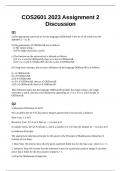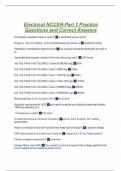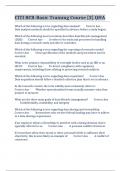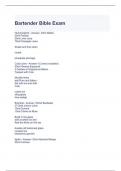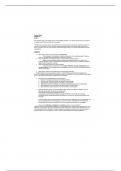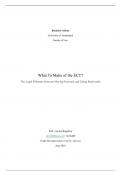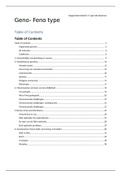Forces and motion 1
NOTES:
- Force is measured in newtons
- UPTHRUST = upwards force
- THRUST = fowards force
- WEIGHT = downwards force
- AIR RESISTANCE = friction through air
- DRAG = friction through water
- Friction can be reduced by adding lubricants like oil
- To increase air resistance, more surface area would be required
- Streamlined shapes enable air to flow past them easily, reducing air resistance/drag
NEWTONS FIRST LAW:
“If the resultant force acting on a object is ZERO, the forces are said to be
BALANCED”
- Resultant force = motion of an object (DIRECTION MATTERS)
To the right
To the right
- If the object is STATIONARY, it will remain STATIONARY
- If the object is MOVING, it will remain to move in the SAME DIRECTION with the
SAME SPEED
----> if the forces on the object are balanced, the object will continue doing
what it’s already doing.
, - Object moving at CONSTANT VELOCITY means that forces on it must be
BALANCED
NEWTONS SECOND LAW:
“If the resultant foce acting on an object is not zero, all the forces are said to be
unbalanced”
- SPEED and DIRECTION may change if forces on object are unbalanced
- On a force diagram, arrows will be UNEVEN
- “Acceleration” takes place in 5 different forms:
● Starting
● Stopping
● Speeding up
● Slowing down
● Change of direction
- RESULTANT FORCE = MASS x ACCELERATION
(F=ma)
- The BIGGER the FORCE, the GREATER the acceleration/deceleration
- The BIGGER the MASS, the SMALLER the acceleration/deceleration
NEWTONS THIRD LAW:
“A force cannot exist on its own, there must always be a second force acting against
it”
- If object a exerts a force on object B, then object B exerts an EQUAL and OPPOSITE
force on object A
- If an object that is lighter pushes against an object that is heavier, the backward
acceleration of the lighter object will be more and vice versa
- The backwards force will be a negative N
, MASS, WEIGHT AND GRAVITY
Gravity:
- Gives everything a WEIGHT
- Makes things accelerate towards the ground (on earth 10m/s^2)
Mass:
- Amount of ‘stuff’ in an object (kg, g, mg)
Weight:
- Caused by the PULL of gravity (measured in N)
MASS AND WEIGHT ARE NOT THE SAME
- An object can have the same mass whether it’s on the earth or moon or wherever but
the WEIGHT will be DIFFERENT, due to the FORCE OF GRAVITY
- WEIGHT = MASS X GRAVITATIONAL FIELD STRENGTH
(w = mg)
- Gravitational field strength is the strength on gravity (usually 10 for earth, 1.6 for
moon but exam questions usually give the planet and g and unless stated, it’s 10)
SCALAR AND VECTORS:
Scalar:
- Has a size (magnitude) ONLY
- Eg degrees, speed, weight, etc
Vectors:
- Has BOTH a size and direction
- Eg velocity, force, momentum, etc
Forces and motion 2
2 EQUATIONS TO FIND VELOCITY/SPEED:
- v^2 = u^2 + 2as
- V = u + at
NOTES:
- Force is measured in newtons
- UPTHRUST = upwards force
- THRUST = fowards force
- WEIGHT = downwards force
- AIR RESISTANCE = friction through air
- DRAG = friction through water
- Friction can be reduced by adding lubricants like oil
- To increase air resistance, more surface area would be required
- Streamlined shapes enable air to flow past them easily, reducing air resistance/drag
NEWTONS FIRST LAW:
“If the resultant force acting on a object is ZERO, the forces are said to be
BALANCED”
- Resultant force = motion of an object (DIRECTION MATTERS)
To the right
To the right
- If the object is STATIONARY, it will remain STATIONARY
- If the object is MOVING, it will remain to move in the SAME DIRECTION with the
SAME SPEED
----> if the forces on the object are balanced, the object will continue doing
what it’s already doing.
, - Object moving at CONSTANT VELOCITY means that forces on it must be
BALANCED
NEWTONS SECOND LAW:
“If the resultant foce acting on an object is not zero, all the forces are said to be
unbalanced”
- SPEED and DIRECTION may change if forces on object are unbalanced
- On a force diagram, arrows will be UNEVEN
- “Acceleration” takes place in 5 different forms:
● Starting
● Stopping
● Speeding up
● Slowing down
● Change of direction
- RESULTANT FORCE = MASS x ACCELERATION
(F=ma)
- The BIGGER the FORCE, the GREATER the acceleration/deceleration
- The BIGGER the MASS, the SMALLER the acceleration/deceleration
NEWTONS THIRD LAW:
“A force cannot exist on its own, there must always be a second force acting against
it”
- If object a exerts a force on object B, then object B exerts an EQUAL and OPPOSITE
force on object A
- If an object that is lighter pushes against an object that is heavier, the backward
acceleration of the lighter object will be more and vice versa
- The backwards force will be a negative N
, MASS, WEIGHT AND GRAVITY
Gravity:
- Gives everything a WEIGHT
- Makes things accelerate towards the ground (on earth 10m/s^2)
Mass:
- Amount of ‘stuff’ in an object (kg, g, mg)
Weight:
- Caused by the PULL of gravity (measured in N)
MASS AND WEIGHT ARE NOT THE SAME
- An object can have the same mass whether it’s on the earth or moon or wherever but
the WEIGHT will be DIFFERENT, due to the FORCE OF GRAVITY
- WEIGHT = MASS X GRAVITATIONAL FIELD STRENGTH
(w = mg)
- Gravitational field strength is the strength on gravity (usually 10 for earth, 1.6 for
moon but exam questions usually give the planet and g and unless stated, it’s 10)
SCALAR AND VECTORS:
Scalar:
- Has a size (magnitude) ONLY
- Eg degrees, speed, weight, etc
Vectors:
- Has BOTH a size and direction
- Eg velocity, force, momentum, etc
Forces and motion 2
2 EQUATIONS TO FIND VELOCITY/SPEED:
- v^2 = u^2 + 2as
- V = u + at


